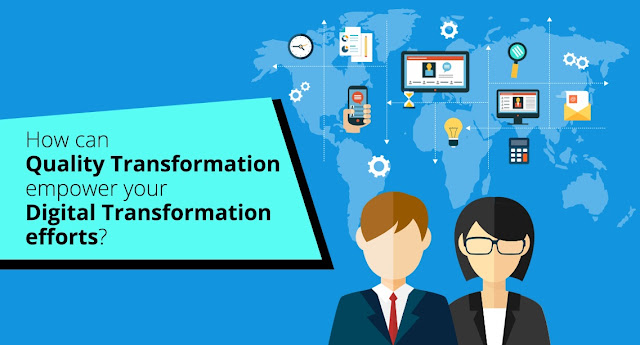The journey of enterprises with digital transformation
 | |
| Digital Transformation |
Digital transformation is no longer a term or marketing
buzzword but has become an indispensable part of the corporate strategy. The
importance of enterprise digital
transformation cannot be brushed aside if any organization wants
to stay competitive and relevant in the industry. The purpose of digital
transformation is not only to embrace new technologies but to generate overall
growth across the organizational ecosystem. This technological transformation
has the potential to drive business growth and accelerate organizational
outcomes.
Digital transformation focuses on the adoption of data-driven technologies by
businesses to deliver better user experiences to the customers. According to
Gordon Cullum, the CTO at Mastek, businesses need to transform in a
post-digital world in order to stay ahead in the competition even as they face
disruptions from peer organizations and start-ups. In reality, digital business transformation facilitates
the development and delivery of quality products, generating great user
experiences, and faster to market.
The importance of digital evolution
among enterprises:
Instead of revolutionizing the business processes with
digital transformation initiatives, organizations evolve according to business
needs and market demands. Digital
transformation solutions help enterprises to pinpoint challenges and
identify the best solution that suits them. It implies organizations make
incremental alterations to enhance the effectiveness of their workflows and
reconstruct them according to the changing market dynamics. This is done
without making any disruption to the primary business processes. This
incremental approach to digital
transformation is often known as digital evolution. While start-up
organizations are agile enough to manage the disruptive technological approach
(for example win or die approach,) for established businesses the risks of
implementing such a strategy may surpass the potential benefits.
The advantages of implementing
Digital Business Transformation:
Digital transformation can accrue a slew of benefits as
given below.
- Cost: Organizations can address the most crucial needs while focusing on the improvements in a rapid manner thereby realizing the ROI. This approach also helps to keep the organizational digital transformation budget in a controlled manner.
- Speed: The digital evolution approach prioritizes the areas that require improvement. Consequently, the time to market is reduced and deployment takes place faster as compared to end-to-end transformation.
- Flexibility: With digital transformation solutions, organizations can set clear short term objectives and iterate the transformation in a synchronized manner later on. This method helps the organization to stay in control with the timeline and budget during the implementation phase. It allows it to adjust the strategy if the business objective needs immediate change.
- Lower risk: Digital evolution does not disrupt ongoing business operations. It works parallel with the operations and is relatively risk-free as compared to the disruptive revolutionary approach. This approach is preferable to the established organizations rather than any start-ups.
According to Jim Smith, the Executive Vice President and
global IT service leader of DXC technology, digital transformation implementation can take place successfully
across a business. The maximization of business value is driven by optimizing
the digital impact across multiple areas, from planning and adoption to
implementation and scale. The implementation of a digital
transformation strategy is solely dependent on an organization's
ability to gather, compile and evaluate substantial amounts of data. At the
same time, it allows reorienting the longstanding business processes at a
parallel level.
According to the research firm Data Crop, sixty percent
of all enterprises would implement comprehensive digital adoptions by next
year. By executing digital makeovers, enterprises that were reliant on
traditional IT infrastructures can now go head to head with peer organizations.
Whether it is a healthcare
application dealing with intricate patient data or a
pharmaceutical organization delivering drug therapies or an insurer managing
risks, enterprises must be able to interlink the technologies and scale as
required.
The transition of businesses as
information-centric enterprises:
Previously, technology decisions were the sole
responsibility of IT departments. However, now, marketing, operations and other
lines of business proactively take part in digital transformation. The stakeholders now realize that
focusing on the optimal usage of data is the key to achieving successful
business outcomes. As organizations become information-oriented, they can
incorporate digital tools such as predictive analytics and cloud resources to
maintain seamless workflows. This helps organizations to carry out things
quickly while making the right business decisions. For example, in the
manufacturing sector, organizations are incorporating the Internet of Things
(IoT) and digital twin technology to produce smart products and enhance
performance using continual data points.
Attaining value with legacy
infrastructures:
As companies move forward with better digital fluency
and skills, they must find out how to bridge the gap between traditional
environments and newly introduced digital technologies. A substantial
percentage of companies are supporting their mainstream IT departments with
hyper-converged infrastructure implemented as self-service clouds.
Organizations are incorporating public cloud services (such as SaaS, Iaas,
PaaS) to further extend their capacities and capabilities.
Conclusion: Organizations across every industry verticals are making an
effort to become more nimble and information-centric to stay competitive. With
the help of digital transformation,
organizations have evolved in such a manner that they can remain accessible to
the end consumers across any channel and at any place. These technological
transformations are modifying traditional business processes and offering them
with capabilities to compete in this digital world.
Diya works for Cigniti Technologies, Global Leaders in
Independent Quality Engineering & Software Testing Services to be
appraised at CMMI-SVC v1.3, Maturity Level 5, and is also ISO 9001:2015 &
ISO 27001:2013 certified.


Comments
Post a Comment